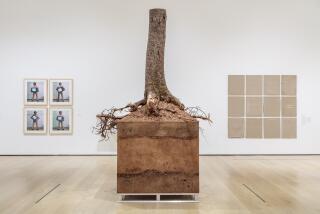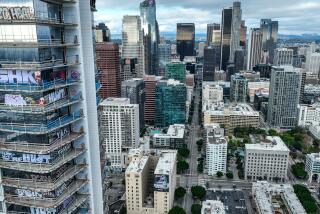The Heart of Paintbrush Diplomacy
Does life follow art? In the case of our kaleidoscopic life on the Pacific Rim, we may desire it to do so. Fortunately, a promising new Asia-Pacific art force may be working to advance the idea of a collective identity, with Southern California as the very happy host of the emerging new consciousness.
âLos Angeles has long been regarded as a mythic promised land,â writes Collette Chattopadhyay in the current Asian Art News, the authoritative, glossy, Hong Kong-based magazine. âPoised like a glistening pearl on the eastern edge of the Pacific Rim, facing East while being West, the city continues to develop as a site for the cultural rendezvous between East and West.â
Really, can East ever meet West? Yup. At a striking exhibition at the Newport Harbor Art Museum in Orange County, Korean American artists, in sculptures, paintings, photographs, prints and site installations, energetically lace the old (Asian traditions) into the new (contemporary America). A Latino art show, âCeremony of Spirit,â recently lit up the Fullerton Art Center. âMemories of Overdevelopment,â a Filipino art collection, ran successfully for weeks at the UC Irvine Art Gallery.
For years, venues like the Remba Gallery in Los Angeles have been sending Latin American art all over the Pacific Rim, from Seoul to Mexico City. The L.A. County Museum of Artâs lavish Pavilion for Japanese Art has, since its debut in 1988, been advancing Japanese work from ancient to modern times; the current special exhibit is of contemporary Japanese photography.
If these gallery and museum trends proceed, Southern California will become the gateway to Asia and the Pacific in art, just as our L.A./Long Beach harbor already is the big tuna for commercial maritime traffic and as Los Angeles International Airport is Americaâs leading portal for Asia-Pacific world travelers and immigrants. As a leading indicator of cultural direction, art can be as significant as the latest breathless Pac Rim trade figure in telling us where we are heading.
A surprising number of Asian artists, especially Koreans, have already met America more than halfway, says Hawaii-born Mark Moore, whose cheery Santa Monica gallery often features Pacific Rim art. âWhile the Koreans do tend to have a different sensibility than us as to what is beautiful,â he says, âthey are very willing to look for kinship with the West, certainly more that most others in Asia. The Japanese, too, have tended to embrace some Western ideas while holding on to their great culture.â
Explains Newport Harbor Art Museum official Maxine Gaiber of the exhibit curated by Korean-American Sarah Lee and supported by the Korean Cultural Center in Los Angeles: âAll these artists in our exhibition were educated in Western art in Korea, so that when they came to America, their art came to look very contemporary and modern.â One striking example is Iktae Rheeâs painting, a sea of Warholesque soup can faces titled âUnification 1995â but speaking to unification of all mankind, not just the two Koreas.
This nascent convergence cannot be a one-way street, collapsing Asian cultures into one huge Big Mac glob of U.S.-driven globalization. As writer Chattopadhyay puts it, âThere is certainly a growing dialogue emerging between Los Angeles gallerists [gallery owners] and the Pacific Rim art world. The Los Angeles gallerists who seem to be experiencing some success in Asia appear to have developed . . . relationships with their overseas colleagues, quite in contrast to the more bullish approach [of] gallerists reaching out across the Atlantic.â
Moore is one who helps organize overseas exhibits for California artists gallery exhibitions overseas. Eric Orr, Laddie John Dill and George Geyer have been well-received in Asia.
The challenge is to find and establish a new synthesis between the competing forces of growing globalization and deep-seated or resurgent nationalism and ethnicity. Indeed, might not our political leaders also benefit from reflecting on the dilemma faced by the artists? As Moore frames the issue, âTo achieve a grand overlay, people must be willing not only to embrace ideas from others but to rethink their own ideas.â How valuable just such an attitude would be in the arena of international relations: to nurture and then nail down a new middle ground that compromises no oneâs soul, identity or patriotism. As Korean-born artist Hyunsook Cho, now living in North Hollywood, paints her ambition: âI draw upon my Korean heritage and develop my personal expression here . . . while celebrating . . . a family of humanity and art that transcends all time, culture and differences.â
If the Pac Rimâs bold, emerging artists can help bring us closer to the idea of a Pac Rim family--the sense of a common destiny among the many nations and people of the Asian Pacific--what a picture that would be. Itâs certainly one that I would buy.
Tom Plateâs column runs Tuesdays. His e-mail address is <[email protected]>.
More to Read
The biggest entertainment stories
Get our big stories about Hollywood, film, television, music, arts, culture and more right in your inbox as soon as they publish.
You may occasionally receive promotional content from the Los Angeles Times.










